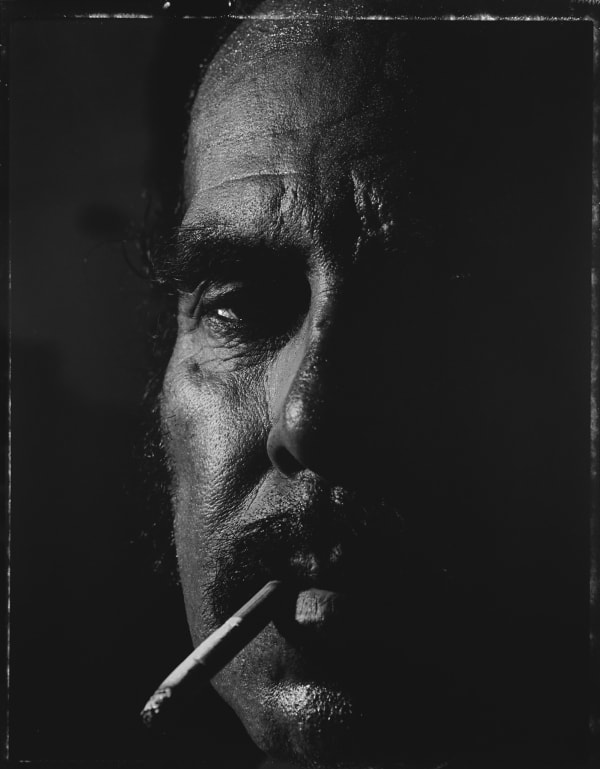-
-
“I'm a product of the border. My grandmother fled Durango, Mexico during the Mexican Revolution to the United States and settled in Chicago. My grandmother loved Chicago and gave birth to my mom and my mom’s two oldest brothers in Chicago, USA. After the stock market crash, the entire family, including the three American kids were forced to relocate to Mexico. More than 400,000 repatriates, many of them citizens of the United States by birth, were deported to Mexico. My father was born and raised in El Paso. When my mom was in her late teens, she lived in Juarez, crossed the border, and worked for my dad. They moved to California, where I was born, in Fresno. Farmworker country, but we lived in the suburbs. When we returned to El Paso to visit relatives, we'd cross the bridge into Juarez so my parents could drink, and my sister and I could buy bull's horns, sombreros, and velvet Jesus paintings. The streets were packed, I held onto my mom's hand in fear I'd lose her grip. But I did. I spun around, and there she was. Mexico staring me in the face -- a stump on a skateboard, amputated, her hand held out begging for Pesos…“
-

Max Aguilera-Hellweg (right,) his sister, and his parents, as captured by a street photographer in Tijuana
-
-

Max Aguilera-Hellweg
TWO BOYS LOOKING FOR CHEAP SMOKES, JUAREZ, I, 1989
Original Type 55 Polaroid (Unique)
4x5 inches
(GCP30310)
-

Max Aguilera-Hellweg
EL CANTEROTYPE , 1989
Signed in pencil in verso
Original Type 55 Polaroid (Unique)
4 X 5
(GCP30272)
-

Max Aguilera-Hellweg
MARIACHI PANTS, 1989
Original Type 55 Polaroid (Unique)
4x5 inches
(GCP30292)
-

Max Aguilera-Hellweg
FIVE MEN, RIO GRANDE, MEXICAN SIDE, 1989
Signed in pencil in verso
Original Type 55 Polaroid (Unique)
4 X 5
(GCP30279)
-

Max Aguilera-Hellweg
TWO UNMARRIED WOMEN WAITING AT BUS STOP FOR RIDE TO A WEDDING, 1989
Original Type 55 Polaroid (Unique)
4x5 inches
(GCP30315)
-

Max Aguilera-Hellweg
THE LOVERS, RIO GRANDE, MEXICAN SIDE, EAST OF PIEDRAS, 1989
Original Type 55 Polaroid (Unique)
4x5 inches
GCP30307
-

Max Aguilera-Hellweg
BOY WITH FATHER AND BROTHER, RIO GRANDE, MEXICAN SIDE, II, 1989
Original Type 55 Polaroid (Unique)
4x5 inches
(GCP31409)
-

Max Aguilera-Hellweg
PROFIRIO, ICE CREAM VENDOR, ABOVE HIM, A CLOUD HANGS IN THE SKY, CIUDAD ACUNA II 1989
Original Type 55 Polaroid (Unique)
4x5 inches
GCP31412
-
-
-
"This project, the work of La Frontera, allowed me to deal with the last residue of confusion I had growing up with a white father and Mexican mother, not being told I was Mexican or had anything Mexican about me. Growing up Mexican in America is to grow up an immigrant in one’s own land. To be amputated at the hip without the language, without the culture, without a sense of history, continuity, or belonging to the rest of Latin America. Although Mexican, I walk different, I wear my jeans different, my Spanish has a Cuban, Argentinean, a Cholo, even sometimes a Catalan accent, wherever I can pick it up. As an itinerant photographer with my black cape, my wooden tripod and a state-of-the-art mahogany and titanium 4x5 field camera, my Type 55 film, I knew who I was always, and in time I finally felt comfortable in my own skin. Yo soy."
La Frontera Sin Sonrisa: Max Aguilera-Hellweg
Current viewing_room
The original work began as a magazine assignment for the LA Times Sunday in the late 1980s.
Max Aguilera-Hellweg was assigned to photograph a street corner in East LA in Boyle Heights where Mariachis congregate and wait for a passing car to stop and get hired for a party, wedding, or quinceañera. Before digital, it was expected that photographers shoot 35mm or 120mm film, and always in color. However, when Aguilera-Hellweg received this assignment, he had recently begun working in 4x5 and had wanted to experiment with Type 55 Polaroid—a film that gives you a Black and White print and a negative. After arriving in Boyle Heights, and seing the scene of Mariachis standing about, all dressed up with nowhere to go, he made the decision that the work had to be shot in black and white Polaroid 4x5 instant film.
This project eventually snowballed into a more expansive project to cover the US/Mexican Border the entire length of Texas from El Paso to Matamoros. Aguilera-Hellweg traveled back and forth along the border for three weeks, setting up his 4x5 in every town he could reach on the Mexican side. Situating himself as an itinerant photographer in the town center, he would take portraits, give the Polaroid to his subject, keep the negative, and move to the next town the next day.












